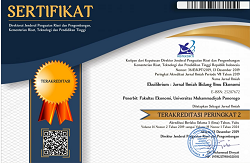The Association between Early Marriage Decisions and Poverty Incidents in Indonesia
DOI: 10.24269/ekuilibrium.v18i2.2023.pp227-236
Abstract
Early marriage is one of the social problems prevalent in many emerging countries, including Indonesia. Early marriage is widely believed to impact future economic outcomes negatively and is also associated with higher poverty incidence. Previous research has shown that early marriage significantly affects an individual’s future welfare and makes them vulnerable to poverty (Dahl, 2010). Research on this issue is still limited in Indonesia, and we aim to pursue the impact of early marriage decisions on poverty, using divorce, dropout, and gender as control variables. We use panel logistic regression on Indonesia Family Life Survey (IFLS) data set. We classify early married individuals as someone who marry under 18 years old, while the poverty variable is measured using the national poverty line. The logistic regression shows that early marriage is significantly associated with lower wages and poverty. The marginal effect of the logistic regression shows that an individual who marries early has a higher probability of getting into poverty, as much as 13-15%. We also found that women are more vulnerable to poverty than male with the exact status of marriage and education level. This result implies that the early marriage problem needs further attention from the policymaker. Regulation of the age of marriage should be reinforced and supported by more stringent measures from local governments.
Keywords
References
- Ashcraft A., Fernández‐Val I., & Lang K. (2013). The Consequences of Teenage Childbearing: Consistent Estimates When Abortion Makes Miscarriage Non‐random. The Economic Journal, 123(571), 875-905.
- Badriah, L. S., & Istiqomah, I. (2022). Does Gender Inequality Lead to Income Inequality? Evidence from Indonesia. Ekuilibrium : Jurnal Ilmiah Bidang Ilmu Ekonomi, 17(1), 1–13. https://doi.org/10.24269/ekuilibrium.v17i1.2022.pp1-13
- Bajracharya, A., & Amin, S. (2012). Poverty, Marriage Timing, and Transitions to Adulthood in Nepal. Studies in Family Planning, 43(2), 79–92. https://doi.org/10.1111/j.1728-4465.2012.00307.x
- Bayisenge, J. (2010). Early Marriage as a Barrier to Girl's Education: A Developmental Challenge in Africa. Journal of Social Psychology, 12(6), 23-48.
- Bramlett M., & Mosher W. (2002). Cohabitation, marriage, divorce, and remarriage in the United States. Vital and health statistics, National Survey of Family Growth, 22, 1-93.
- Broer M., & Bai Y. (2019). Socioeconomic Inequality and Educational Outcomes. Springer International Publishing, 5.
- Dahl, G. B. (2010). Early teen marriage and future poverty. Demography, 47(3), 689–718. https://doi.org/10.1353/dem.0.0120
- Damayanti, C. (2020). Ketimpangan Gender dan Pernikahan Usia Dini. Asean Youth Initiative Conference. https://ayic.unpad.ac.id/ketimpangan-gender-dan-pernikahan-usia-dini/
- Delprato, M., Akyeampong, K., Sabates, R., & Hernandez-Fernandez, J. (2015). On the impact of early marriage on schooling outcomes in Sub-Saharan Africa and South West Asia. International Journal of Educational Development, 44, 42–55. https://doi.org/10.1016/j.ijedudev.2015.06.001
- Djamilah, D., & Kartikawati, R. (2014). Impact of Child Marriage in Indonesia. Journal of Youth Studies, 3(1).
- Fletcher J., & Wolfe B. (2008). Education and Labor Market Consequences of Teenage Childbearing: Evidence Using the Timing of Pregnancy Outcomes and Community Fixed Effects. National Bureau of Economic Research, Cambridge.
- Hotz V., Sanders S., & McElroy S. (1999). Teenage Childbearing and Its Life Cycle Consequences: Exploiting a Natural Experiment. National Bureau of Economic Research, Cambridge.
- Jordan, A. H., & Zitek, E. M. (2012). Marital Status Bias in Perceptions of Employees. Basic and Applied Social Psychology, 34(5), 474–481. https://doi.org/10.1080/01973533.2012.711687
- Jordan, G. (2004). The causes of poverty cultural vs. structural: Can there be a synthesis? Perspectives in Public Affairs. Spring, 18–34.
- Kabir M., Ghosh S., & Shawly A. (2019). Causes of Early Marriage and Its Effect on Reproductive Health of Young Mothers in Bangladesh. American Journal of Applied Sciences, 16(9), 289-297.
- Kattel, R., Kregel, J. A., & Reinert, E. S. (Eds.). (n.d.). Problems of Capital Formation in Underdeveloped Countries (1953). In Ragnar Nurkse: Trade and Development (pp. 99–212). Anthem Press. https://doi.org/10.7135/UPO9781843318187.010
- Katz, L. F., & Autor, D. H. (1999). Changes in the Wage Structure and Earnings Inequality (pp. 1463–1555). https://doi.org/10.1016/S1573-4463(99)03007-2
- Kelly, J. (2007). Divorce: Causes and Consequences - By Alison Clarke-Stewart and Cornelia Brentano. Family Court Review, 45(2), 341-344.
- Kuncoro, M. (2006). Ekonomika Pembangunan: Teori, Masalah, dan Kebijakan. UPP Akademi Manajemen Perusahaan YKPN.
- Kyari G., & Ayodele J. (2014). The Socio-Economic Effect of Early Marriage in North Western Nigeria. Mediterranean Journal of Social Sciences, 5(14).
- Lleras-Muney, A. (2005). The Relationship Between Education and Adult Mortality in the United States. Review of Economic Studies, 72(1), 189–221. https://doi.org/10.1111/0034-6527.00329
- Murray, D. (2012). The Impact of Divorce on Work Performance of Professional Nurses in The Tertiary Hospitals of The Buffalo City Municipality. University of Fort Hare.
- Otoo-Oyortey, N., & Pobi, S. (2003). Early marriage and poverty: exploring links and key policy issues. Gender & Development, 11(2), 42–51. https://doi.org/10.1080/741954315
- Pratama, Y., Samudro, B., & Yogi, A. (2018). Breastfeeding : Gender and Socio-Economic Dimensions. Ekuilibrium: Jurnal Ilmiah Bidang Ilmu Ekonomi, 13(1), 67.
- Rahayu, W. D., & Wahyuni, Ph. D. , H. (2020). The Influence of Early Marriage on Monetary Poverty in Indonesia. Journal of Indonesian Economy and Business, 35(1). https://doi.org/10.22146/jieb.42405
- UNICEF. (2005). Early Marriage: A Harmful Traditional Practice: A Statistical Exploration.
- Wibowo, A. R., & Khoirudin, R. (2019). Analysis of Determinants of Poor Population in Central Java 2008-2017. Ekuilibrium : Jurnal Ilmiah Bidang Ilmu Ekonomi, 14(1), 1. https://doi.org/10.24269/ekuilibrium.v14i1.1482
- Yani, A., Restiatun, R., & Suradi, R. (2022). Poverty Rates and The Factors Influencing Poverty Alleviation: A Case Study in The Province of West Kalimantan, Indonesia. Ekuilibrium : Jurnal Ilmiah Bidang Ilmu Ekonomi, 17(1), 23.
Refbacks
- There are currently no refbacks.

This work is licensed under a Creative Commons Attribution-ShareAlike 4.0 International License.













